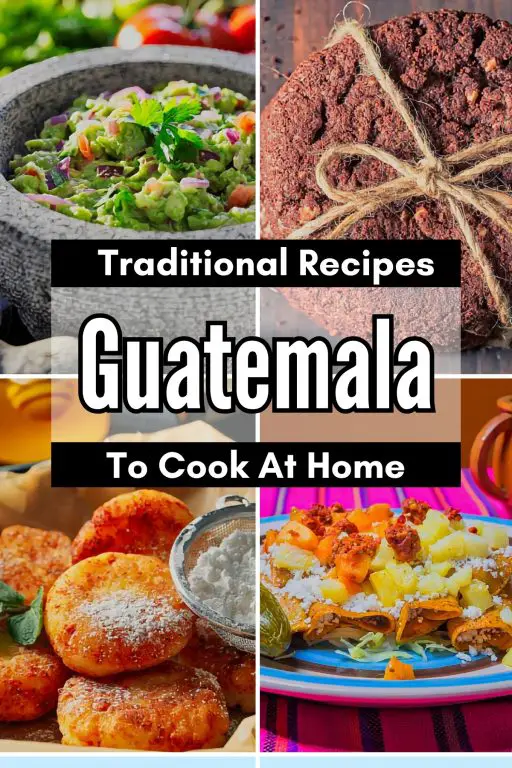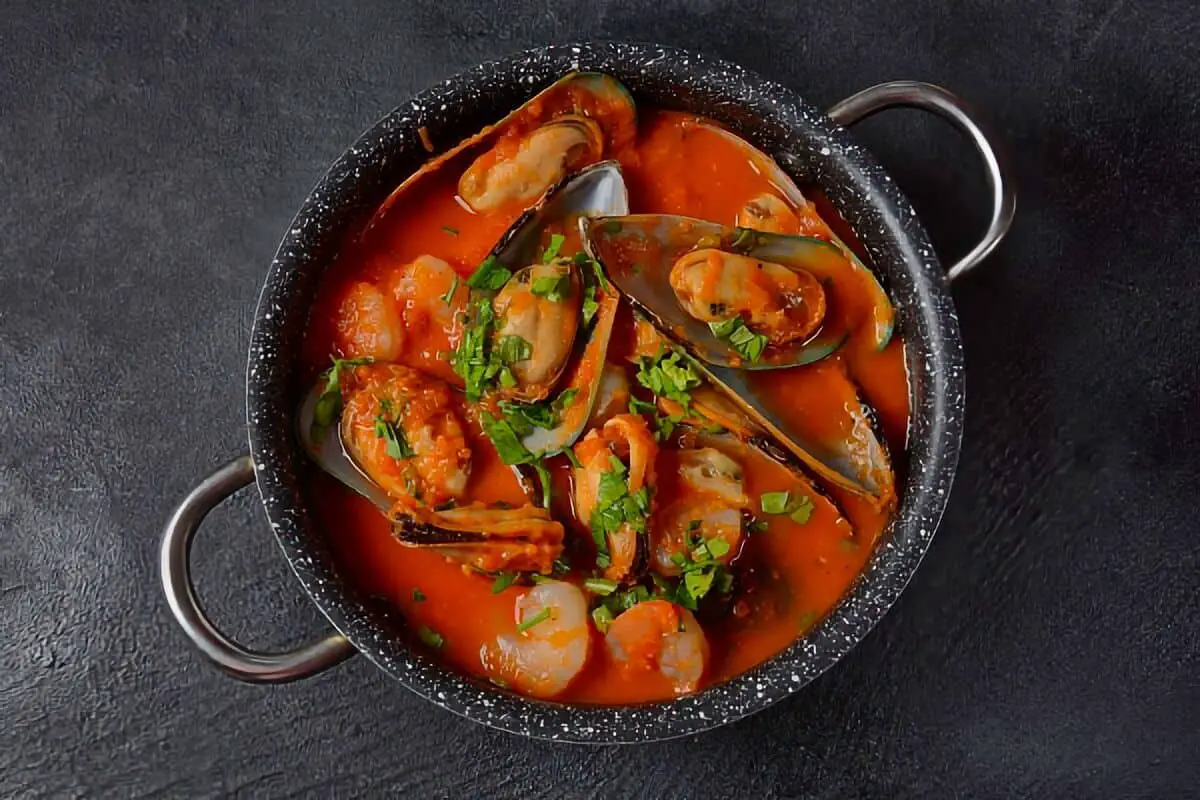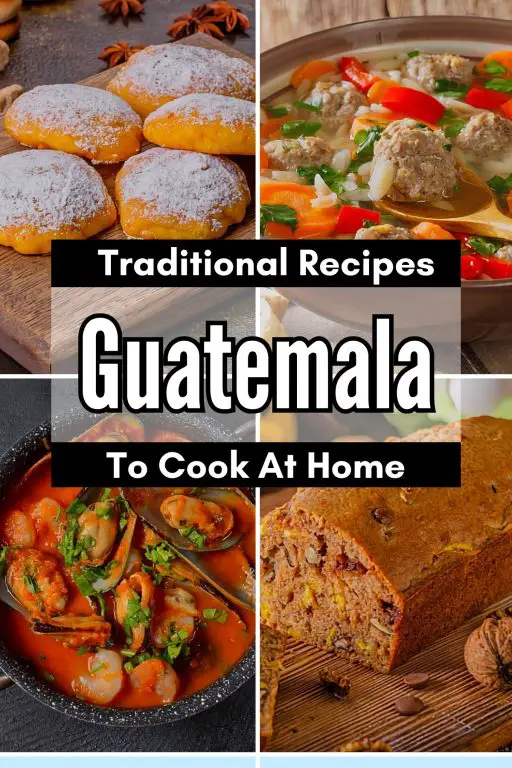The highlight of my Guatemalan Tapado recipe was my cooking class in Mixco. This town near Guatemala City has an important history and cultural meaning. Mixco has attractions like the Mixco Viejo archaeological site, where visitors can see the remains of the ancient Mayan civilization. Mixco has many local markets and streets to explore.
In cooking class, I learned how to make Tapado, a traditional seafood soup that showcases the coastal flavors of Guatemala. It is typically made with seafood like fish, octopus, and shrimp, along with vegetables and coconut milk. As I gathered the ingredients, I noticed how fresh and high-quality the produce was at the local markets. It was clear that people in the area prefer to use fresh ingredients in their meals.
I felt good about the Guatemalan Tapado recipe as we began to cook it. We started by cooking peppers, garlic, and onions to make the soup base. The aroma of the cooking vegetables was welcoming and prepared everyone for what was about to happen next. After the base was ready, we mixed in diced tomatoes and coconut milk.
After we made the broth, we added the seafood to the pot. The combination of fish, shrimp, and octopus was intriguing, and each ingredient contributed to the overall flavor. The Tapado recipe definitely needs seafood and coconut milk, showing off the flavors of Guatemalan coastal cooking.
While the soup was cooking, we prepared avocado slices and lime wedges, which are usually served with Tapado. The dish had a creamy texture, and the seafood was cooked just right. Every spoonful had a mix of flavors: salty, sweet, and a tangy kick from the lime. Guatemalan Tapado is a popular dish enjoyed by families during special events and gatherings.
Tapado is very popular in Mixco and the nearby areas, and you can find it in many local restaurants. This place is a favorite for people looking for traditional Guatemalan food. The soup has seafood and coconut milk, making it a refreshing choice in hot weather.
After the cooking class, I explored more of Mixco, visited local markets, and tasted other traditional foods. People hung out and ate together in the town. Making the Guatemalan Tapado recipe helped me understand the local culture and how food can bring people together.
My trip to Mixco and the cooking class for the Guatemalan Tapado recipe was both informative and enjoyable. The preparation was simple, and the flavors were rich and enjoyable. Making Tapado helped me connect with local cooking traditions, and I want to share this recipe with others who want to try Guatemalan food. This experience showed how food is an important part of community and culture, making my time in Mixco unforgettable.
Ingredients For the Guatemalan Tapado Recipe
Assorted Seafood (shrimp, fish fillets, squid, mussels, etc.)
Vegetable Oil
Diced Onion
Minced Cloves Garlic
Diced Bell Pepper
Diced Tomatoes
Coconut Milk
Fish or Vegetable Broth
Ground Cumin
Paprika
Dried Oregano
Bay Leaf
Salt
Pepper
Fresh Cilantro or Parsley
Lime Wedges
Cooking Instructions For the Guatemalan Tapado Recipe
Prepare the Ingredients – Chop the onion, garlic, bell pepper, and tomatoes. Clean and devein the shrimp, if needed. Cut the fish fillets into bite-sized pieces. Rinse and scrub the mussels, discarding any that are open or damaged. Gather all the necessary spices and herbs.
Sauté the Aromatics – Heat the vegetable oil in a large pot or Dutch oven over medium heat. Add the diced onion and cook until softened. Stir in the minced garlic and cook for another minute. Add the diced bell pepper and cook until slightly tender. Incorporate the diced tomatoes and cook until they start to break down.
Add the Broth and Coconut Milk – Pour in the fish or vegetable broth, stirring well. Stir in the coconut milk, ensuring it is well combined. Add the ground cumin, paprika, dried oregano, and bay leaf. Season with salt and pepper to taste. Bring the mixture to a gentle simmer.
Cook the Seafood – Add the assorted seafood to the pot, starting with the fish fillets. Allow the fish to cook for a few minutes before adding the shrimp. Add the squid and mussels, arranging them evenly in the pot. Cover the pot and simmer until the seafood is cooked through. The shrimp should turn pink, the fish should be flaky, and the mussels should open.
Serve the Guatemalan Tapado – Remove the bay leaf from the pot. Ladle the stew into serving bowls, ensuring each bowl has a good variety of seafood. Garnish with freshly chopped cilantro or parsley. Serve the stew hot with lime wedges on the side. Enjoy this delicious Guatemalan Tapado with Coconut Milk with warm tortillas or crusty bread.
Eating Healthy in Guatemala
Eating healthy in Guatemala is achievable, thanks to the country’s abundant fresh produce, local markets, and traditional cooking methods that prioritize natural ingredients. Guatemala’s varied landscape, which includes fertile highlands and tropical lowlands, allows for a diverse range of fruits, vegetables, and grains. Staples like black beans, corn, and rice form the base of many dishes and offer a nutritious source of protein, fiber, and essential vitamins. Black beans, in particular, are a common ingredient in Guatemalan meals, providing protein and fiber without saturated fats, making them a great choice for a balanced diet. Paired with corn tortillas — a daily staple rich in fiber and antioxidants — these ingredients are satisfying and help maintain energy levels throughout the day.
One of the most beneficial aspects of Guatemalan cuisine is its emphasis on fresh vegetables and fruits. Local markets, or mercados, are filled with seasonal produce such as tomatoes, avocados, carrots, and leafy greens. Vegetables are often incorporated into traditional dishes like caldo de res, a hearty beef soup loaded with nutrient-dense vegetables, or jocon, a chicken stew made with tomatillos and cilantro. The vibrant colors in these dishes reflect the high vitamin and antioxidant content that supports overall health, making it easy to get essential nutrients through regular meals.
In addition to vegetables, tropical fruits such as papaya, mango, and bananas are commonly available, offering essential vitamins like vitamin C and potassium. These fruits are often enjoyed fresh, juiced, or as a light snack, providing natural sugars and hydration in the country’s warmer regions. The emphasis on fresh, whole foods is also reflected in Guatemalan drinks, where fruit-based beverages and traditional teas are common, reducing the need for processed, sugar-laden options.
Guatemalan cooking methods also support a healthier diet. Many dishes are simmered, boiled, or lightly sautéed rather than fried, preserving the nutritional value of ingredients without adding unnecessary fats. Traditional stews, like pepian and hilachas, are slow-cooked with minimal oil, allowing spices, herbs, and vegetables to enhance the flavor naturally. This approach not only brings out the authentic flavors of the ingredients but also aligns with the principles of healthy eating by reducing added fats and sugars.
Overall, Guatemala’s local markets, traditional foods, and natural cooking techniques make it easy to eat healthily. Embracing these customs allows individuals to enjoy a balanced, nutrient-rich diet rooted in fresh, wholesome ingredients, supporting wellness and long-term health.
Finding the Best Food in Guatemala
Finding the best food in Guatemala takes you through the country’s cultural heritage, regional flavors and fresh ingredients. Guatemala’s food scene is based on Mayan and Spanish traditions and produces filling dishes representative of the country’s varied landscapes. For genuine Guatemalan foods, check out local markets, regional specialties or family-owned eateries – every one of that will provide you a genuine flavor of Guatemalan food.
A great starting point is Guatemala City, where the diverse food culture showcases traditional and contemporary options. Local markets such as Mercado Central are full of stalls selling street foods like antojitos (snacks) and tamales. Tamales are corn masa rolled in banana leaves and filled with meats, vegetables and spices; each region has its own version. Street vendors may sell freshly prepared atoles as well as a warm, thickened drink made from corn to start the day. For those looking to sample all the Guatemalan flavors in one meal, Guatemala City also has restaurants serving regional dishes from across the country.
Another excellent place to consume is Antigua Guatemala, a historic city and popular attraction that includes both traditional and contemporary eateries. Here, visitors can enjoy pepian, a thick, aromatic stew that is a national dish, made with meats, roasted vegetables and spices such as pumpkin seeds and sesame. Some restaurants in Antigua prepare pepian and other traditional dishes using traditional methods such as cooking on an open flame or in clay pots. The region also has street foods such as chuchitos, small tamales wrapped in corn husks, so you can grab some local fare while you’re in the city.
Another area with special culinary offerings is Lake Atitlán in the highlands, known for its fresh fish dishes. Here, visitors can enjoy mojarra frita, fried fish seasoned with local herbs and spices, with rice and vegetables. Small towns around the lake, such as Panajachel and Santiago Atitl’n, have restaurants and food stalls offering local cuisine. Many of these eateries use produce around the lake and from local farms to create sustainable, fresh meals that reflect the region’s culinary identity.
For more traditional indigenous fare, the Guatemalan Highlands, particularly areas around Quetzaltenango (Xela), serve a hearty turkey soup with a thick red broth made from tomatoes and chili peppers, a staple dish of the K’iche’ people. Restaurants serve kak’ik prepared from recipes passed down from generation to generation in Xela and nearby villages. This dish, along with other local specialties like jocon (a green tomatillo and cilantro stew) showcases some of the flavors and traditions that make Guatemalan food special.
Finding the best food in Guatemala often means adopting the local culture, sampling regional flavors and visiting markets and eateries where locals congregate. Whether you’ re eating street food in Guatemala City, lake fish at Atitlán or stews in the Highlands, the country’s food culture is accessible and welcoming. This approach to Guatemalan food creates an authentic culinary experience, where each meal opens a window onto the regions, history and people of Guatemala.
 FAQ For the Guatemalan Tapado Recipe
FAQ For the Guatemalan Tapado Recipe
Q: What ingredients are needed for the Guatemalan Tapado recipe?
A: To prepare the Guatemalan Tapado recipe, you will need a variety of fresh ingredients that create a rich and flavorful seafood soup. The base typically consists of coconut milk, which adds creaminess and a unique tropical flavor. You will also require a mix of seafood, such as fish, shrimp, and sometimes octopus, along with vegetables like plantains, potatoes, and tomatoes. Seasonings like garlic, cilantro, and lime juice help enhance the dish’s taste, making it a hearty and satisfying meal that reflects the coastal flavors of Guatemala.
Q: How do I cook the Guatemalan Tapado recipe?
A: Cooking the Guatemalan Tapado recipe involves a few simple steps that bring all the ingredients together. Start by sautéing onions and garlic in a large pot until fragrant. Then, add the vegetables, followed by the coconut milk and enough water or broth to create a soupy consistency. Once the mixture reaches a gentle boil, carefully add the seafood and let it simmer until everything is cooked through. The final touch is to add fresh herbs and lime juice just before serving to enhance the flavor, resulting in a delicious and aromatic dish.
Q: Can I make variations of the Guatemalan Tapado recipe?
A: Absolutely, you can create variations of the Guatemalan Tapado recipe to suit your taste or dietary preferences. While traditional recipes use specific types of seafood, you can substitute or add different varieties based on what is available or what you enjoy most. For instance, if you prefer a vegetarian option, you might use mushrooms and additional vegetables while omitting the seafood. Adjusting spices and seasonings is also an option, allowing you to tailor the dish to your liking while still keeping its essence.
Q: How long does it take to prepare the Guatemalan Tapado recipe?
A: The Guatemalan Tapado recipe can be prepared relatively quickly, making it a convenient option for a hearty meal. Overall, you can expect the preparation and cooking time to be around 45 minutes to an hour. This includes chopping the vegetables, sautéing the aromatics, and allowing the soup to simmer so that all the flavors meld together perfectly. The time invested is well worth it, as the final result is a rich and flavorful soup that can be enjoyed by the whole family.
Q: What should I serve with the Guatemalan Tapado recipe?
A: When serving the Guatemalan Tapado recipe, consider pairing it with traditional accompaniments that enhance the dining experience. A side of warm corn tortillas or rice complements the soup perfectly, allowing you to soak up the delicious coconut broth. You might also want to serve a fresh salad or some avocado slices for a refreshing contrast to the rich flavors of the soup. Finally, a wedge of lime can be served on the side to add a zesty touch that brightens the entire meal.

Guatemalan Tapado Recipe
Equipment
- Large pot or Dutch oven: Used to cook the stew and simmer the ingredients.
- Wooden spoon or spatula: Used for stirring and mixing the ingredients.
- Cutting board: Used for chopping and preparing the vegetables.
- Chef's knife: Used for cutting and slicing the ingredients.
- Ladle: Used for serving the stew into bowls.
- Serving bowls: Used to serve the Guatemalan Tapado.
- Lime squeezer: Optional but helpful for extracting juice from lime wedges.
- Tongs: Used for handling and arranging the seafood in the pot.
Ingredients
- 2 pounds shrimp shrimp, fish fillets, squid, mussels, etc.
- 1 tablespoon vegetable oil
- 1 onion diced
- 3 cloves garlic minced
- 1 bell pepper diced
- 2 tomatoes diced
- 2 cups coconut milk
- 2 cups fvegetable broth or fish broth
- 1 teaspoon cumin ground
- 1 teaspoon paprika
- 1 teaspoon oregano dried
- 1 bay leaf
- Salt and pepper to taste
- Fresh cilantro or parsley chopped (for garnish)
- Lime wedges for serving
Instructions
Prepare the Ingredients:
- a. Chop the onion, garlic, bell pepper, and tomatoes.
- b. Clean and devein the shrimp, if needed.
- c. Cut the fish fillets into bite-sized pieces.
- d. Rinse and scrub the mussels, discarding any that are open or damaged.
- e. Gather all the necessary spices and herbs.
Sauté the Aromatics:
- a. Heat the vegetable oil in a large pot or Dutch oven over medium heat.
- b. Add the diced onion and cook until softened.
- c. Stir in the minced garlic and cook for another minute.
- d. Add the diced bell pepper and cook until slightly tender.
- e. Incorporate the diced tomatoes and cook until they start to break down.
Add the Broth and Coconut Milk:
- a. Pour in the fish or vegetable broth, stirring well.
- b. Stir in the coconut milk, ensuring it is well combined.
- c. Add the ground cumin, paprika, dried oregano, and bay leaf.
- d. Season with salt and pepper to taste.
- e. Bring the mixture to a gentle simmer.
Cook the Seafood:
- a. Add the assorted seafood to the pot, starting with the fish fillets.
- b. Allow the fish to cook for a few minutes before adding the shrimp.
- c. Add the squid and mussels, arranging them evenly in the pot.
- d. Cover the pot and simmer until the seafood is cooked through.
- e. The shrimp should turn pink, the fish should be flaky, and the mussels should open.
Serve the Guatemalan Tapado:
- a. Remove the bay leaf from the pot.
- b. Ladle the stew into serving bowls, ensuring each bowl has a good variety of seafood.
- c. Garnish with freshly chopped cilantro or parsley.
- d. Serve the stew hot with lime wedges on the side.
- e. Enjoy this delicious Guatemalan Tapado with Coconut Milk with warm tortillas or crusty bread.




1 comment
The seafood in this coconut broth was rich and absolutely packed with flavour.
Comments are closed.